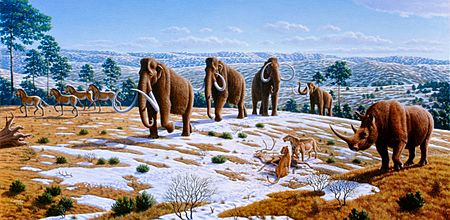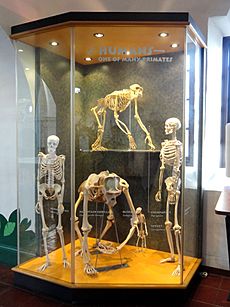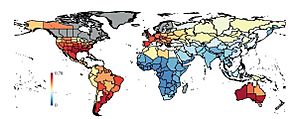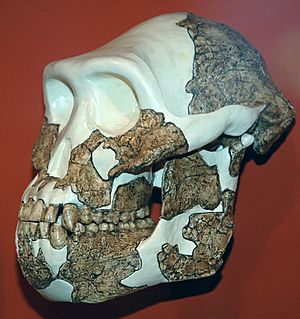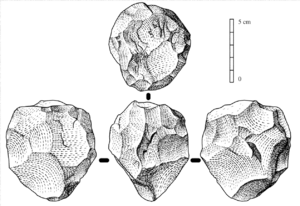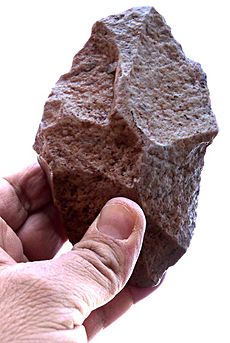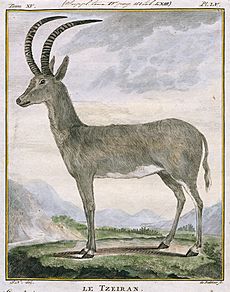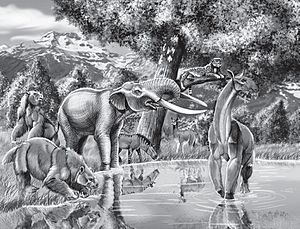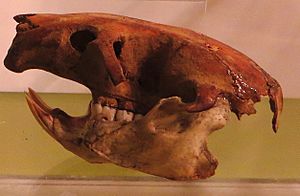Pleistocene megafauna facts for kids
Pleistocene megafauna refers to the huge animals that lived on Earth during the Pleistocene period. Many of these large creatures disappeared during a big extinction event called the Quaternary extinction event. The word "megafauna" means any animal that weighs more than 45 kilograms (about 99 pounds) when it's an adult.
Some of these amazing animals included the straight-tusked elephant, cave bear, a type of rhinoceros called Stephanorhinus, the heavy Spirocerus antelope, ancient hippos, woolly rhinoceros, mammoths, giant deer, the sabre-toothed cat (Homotherium), cave lion, and even leopards in Europe.
Contents
The Ice Age World
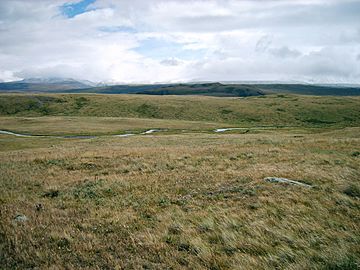
The last major Ice Age, which scientists call the 'last glacial period', happened between 125,000 and 14,500 years ago. This was the coldest part of the current ice age, and it happened at the end of the Pleistocene period. During the coldest time, about 26,500 years ago, huge sheets of ice covered much of the Earth. These ice sheets started melting around 19,000 years ago in the Northern Hemisphere.
A vast grassland, known as the mammoth steppe, stretched from Spain all the way across Europe and Asia. It even crossed a land bridge called Bering land bridge into Alaska and Canada. This land bridge existed because so much of the Earth's water was frozen in glaciers, making sea levels much lower than today. When the ice melted, the sea levels rose, and this land bridge disappeared about 11,000 years ago. During the Ice Age, Europe was much colder and drier. Most of it was covered in steppe or tundra, with very few forests.
Scientists have found fossils on many continents that show most large animals died out around the end of the last Ice Age. These are the animals we call Pleistocene megafauna. For example, the straight-tusked elephant disappeared in Eurasia between 100,000 and 50,000 years ago. The cave bear, Stephanorhinus rhino, Spirocerus antelope, and Eurasian hippos died out between 50,000 and 16,000 years ago. The woolly rhinoceros and mammoths disappeared between 16,000 and 11,500 years ago. Some mammoths even survived on Wrangel Island until about 4,500 years ago!
When these large plant-eaters disappeared, their predators also struggled. The sabre-toothed cat (Homotherium) died out 28,000 years ago. The cave lion disappeared 11,900 years ago, and leopards vanished from Europe 27,000 years ago. The late Pleistocene had many quick and big climate changes, with temperatures sometimes changing by as much as 16°C. These changes are linked to the megafauna extinctions. However, there's no evidence that extinctions happened during the coldest part of the Ice Age. This suggests that just being cold wasn't the only reason.
Modern humans first appeared in East Africa about 195,000 years ago. Some groups started moving out of Africa 60,000 years ago. They reached Europe about 43,000-45,000 years ago. Another group traveled to Siberia, far north, 27,000 years ago. Evidence of humans hunting mammoths 45,000 years ago has been found in Siberia. Humans then crossed the Bering land bridge into North America between 20,000 and 11,000 years ago. This was after the big ice sheets had melted but before the land bridge was covered by the sea. These people then spread across the Americas. Around 11,500 years ago, farming began in the Fertile Crescent.
Why Did They Disappear?
Scientists have four main ideas about why these large animals went extinct:
- Hunting by humans: This idea, called the "overkill hypothesis," suggests that humans hunted too many animals.
- Climate change: The Earth's climate changed a lot at the end of the last Ice Age.
- Disease: New diseases could have wiped out animal populations.
- Asteroid or comet impact: A large space rock hitting Earth could have caused widespread destruction.
It's possible that a combination of these factors led to the extinctions. However, climate change and the overkill hypothesis have the most evidence supporting them. Many scientists lean towards the idea that human hunting played a big role.
It's a big debate among scientists. When humans arrived in an area, megafauna often disappeared. But at the same time, the climate was also getting warmer. Being large helped animals stay warm in cold climates. So, a warming climate would have been tough for them. However, some animals just became smaller over time. There's strong evidence that humans hunted animals like mammoths in North America. But in Australia, there's less evidence for hunting most of the extinct megafauna, except for a large bird. A 2017 study suggested that humans were the main reason for the extinction of Australian megafauna.
Where Did Extinctions Happen?
While North America saw the biggest loss of megafauna, Europe, Asia, Africa, and islands also experienced extinctions.
Africa
Africa also lost some large mammal species during the late Pleistocene and early Holocene periods. About 24 large mammal species (over 45 kg) disappeared from continental Africa between 13,000 and 6,000 years ago. Most of these were grazing animals that lived in grasslands. Other studies suggest that over 27 species were lost in the last million years. So, it's clear that Africa also lost a lot of its animal diversity.
Early Humans and Extinction
At many sites in Africa, scientists have found early human tools, like handaxes, alongside the bones of large animals. These tools, called Acheulean tools, were made from stone and were often pear-shaped. Early human ancestors, like Homo erectus, used these tools for many things. They could butcher animals, cut wood, dig, and scrape. These tools were used for about a million years. The oldest Acheulean tools, over 1.6 million years old, were found in Africa.
There's a debate about whether these early humans, using simple stone tools, could have caused the extinction of megafauna in Africa. Some scientists believe that early human ancestors might have contributed to the loss of Africa's largest plant-eaters and meat-eaters. However, many modern experts think that the evidence for this is not strong enough. They argue that the extinctions should be looked at alongside long-term changes in the environment and animal life.
Other scientists suggest that environmental changes were the main cause of megafauna extinction in Pleistocene Africa. They point out that grassland animals disappeared when their habitats changed. This could be due to changes in how the land was structured, where plants grew, or how much food was available. This idea suggests that human impact was minimal, and environmental factors were more important.
African Megafauna That Disappeared
Some of the large animals that lived in Africa during the Pleistocene and later disappeared include:
- Primates: Gorgopithecus, Dinopithecus, Simopithecus.
- Carnivores: Megantereon, Homotherium, Machairodus.
- Bovidae (cattle-like animals): Homoioceras, Pelorovis, Megalotragus.
Compared to North America, Africa had a less intense megafauna extinction. For example, North America lost about 71% of its large mammal genera in the late Pleistocene, while Africa lost about 39%. This shows that North America experienced a much bigger loss.
Why Africa Was Different
Sub-Saharan Africa is unique because it still has many of the large animals that lived there during the Pleistocene. These include the African bush elephant, African forest elephant, black rhinoceros, white rhinoceros, and hippopotamus. All the largest plant-eating groups from Pleistocene Africa are still around today. Overall, only about 5% to 18% of Africa's large animals went extinct, which is much lower than other continents.
Scientists have a few ideas why Africa had fewer extinctions:
- Less Study: Some think that the extinctions in Africa haven't been studied as much as in other places. More research might reveal more extinct species.
- Coexistence with Humans: Another idea is that Africa's megafauna evolved alongside different types of early humans for a very long time. This meant they learned to deal with human hunting pressure. So, humans and megafauna could live together, and the huge extinctions seen in the Americas and Australia didn't happen in Africa.
While climate change is a big reason for extinctions elsewhere, it's not thought to be the main cause in Africa. This is because South America has a similar climate to Sub-Saharan Africa, but it had many more extinctions.
Even with fewer extinctions, some African megafauna did disappear. One was Pelorovis antiquus, the Long-horned African Buffalo. It died out completely about 4,000 years ago. Another was the giant antelope Megalotragus priscus, which disappeared about 7,500 years ago. The Cape Zebra (Equus capensis) also went extinct. The blue antelope (Hippotragus leucophaeus) survived the Ice Age but went extinct in 1800 after European settlers arrived. Its habitat was reduced, and it was overhunted.
North America
During the American megafaunal extinction event, around 12,700 years ago, North America lost 70% of its large mammal species. This included 90 groups of mammals weighing over 44 kilograms. The large animals in North America during the late Pleistocene included giant sloths, short-faced bears, tapirs, peccaries, the American lion, giant tortoises, "American cheetahs" (Miracinonyx), the saber-toothed cat Smilodon, dire wolves, saiga, camelids like llamas and Camelops, bison, stag-moose, shrub-ox, pronghorn, horses, mammoths, mastodons, beautiful armadillos, giant armadillo-like Glyptotherium, and giant beavers. There were also huge birds like giant condors and teratorns.
The reasons for this extinction event are still debated. Most scientists agree that both climate change and human hunting played a role. Human hunting could have directly killed too many animals. It could also have caused problems for other animals by changing the food chain. Some researchers believe that the arrival of Clovis hunters and a big increase in human population around 13,000 years ago led to more hunting. At the same time, around 12,000 years ago, a global cooling event called the Younger Dryas (YD) happened. This would have greatly affected the habitats and food sources for many megafauna.
It's hard to say exactly what caused the extinctions across the whole continent. The climate and human impacts varied in different places and at different times. So, the causes might have been different for different species and regions. For example, the extinction of mammoths, horses, and saber-toothed cats seems to be linked to human activity. Humans directly hunted mammoths and horses. Saber-toothed cats might have died out because humans overhunted their prey. However, the extinctions of the Shasta ground sloth and mastodon don't seem to be linked to human hunting.
Alaska
In Alaska, megafauna disappeared earlier than in other parts of North America. This means they either died out locally or moved south because of the Younger Dryas cooling event. Megafauna disappeared from Alaska about 1,000 to 4,000 years before many humans arrived there. This suggests that climate change was likely the main reason for their disappearance in this region.
The Great Lakes Region
In the Great Lakes Region, megafauna disappeared later than in Alaska. Humans also arrived in this region much earlier than in other parts of North America. Fossils suggest that humans and megafauna lived together in this area for about 7,000 years. However, even with humans present, scientists believe that both climate change and human impacts together caused the extinctions in this region.
The West and Pacific Coast
The Pacific Coast was one of the first places where early Indigenous Peoples might have migrated south from Alaska. However, there seems to have been little overlap between humans and megafauna species in these areas. One reason for this might be that rising sea levels have covered older coastal sites, making it hard to find evidence.
Indigenous Knowledge of Ancient Animals
Indigenous peoples have kept knowledge of Pleistocene megafauna alive through their oral traditions and rock art (petroglyphs).
The Cayuse people in the Pacific Northwest have stories and a dance about mammoths migrating into their land. Mammoth teeth have been found on the Umatilla Indian Reservation, where the Cayuse people live.
An Osage tradition tells of a battle between mastodons and mammoths in the Great Plains. This battle left many animals dead, and the Osage burned them. Later, settlers found mastodon and mammoth bones at this site.
Across western North America, there are many stories about huge, black-winged birds called thunderbirds. These stories are similar to species from the genus Teratornis, which are found in the fossil record of the west coast.
South America
About 10,000 years ago, South America was home to many unique megafauna species. These included bears, saber-toothed cats, large capybaras, and llamas. There were also enormous sloths that lived on the ground, armored glyptodonts (like an armadillo, but as big as a hippo), and animals similar to camels and rhinoceroses (like macrauchenids and toxodonts). All South American mammal species larger than 100 kg disappeared during the Quaternary Period. Scientists are still debating why this happened.
South America was separated from other continents for millions of years during the Cenozoic Period. This allowed unique animals to evolve there. About 3 million years ago, the Isthmus of Panama formed, connecting North and South America. This led to the Great American Interchange, where animals from both continents mixed. This mixing created new chances for species to spread, compete, and replace each other.
Some of the large animals in Pleistocene South America included the giant ground sloth Megatherium. There were also many plant-eaters like the camel-like Macrauchenia, Cuvieronius, Doedicurus, Glyptodon, Hippidion, and Toxodon. Stegomastodons were found as far south as Patagonia. The main predators were Arctotherium and Smilodon.
Eurasia
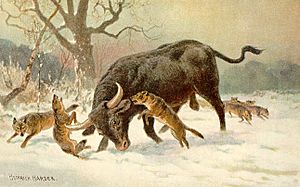
Eurasia also had many large animals similar to those in North America. Some well-known Eurasian species were the woolly mammoth, steppe mammoth, straight-tusked elephant, European hippos, aurochs, steppe bison, cave lion, cave bear, cave hyena, Homotherium, Irish elk, giant polar bears, woolly rhinoceros, Merck's rhinoceros, narrow-nosed rhinoceros, and Elasmotherium. Today, the largest land mammal in Europe is the European bison, or wisent.
As modern humans (Homo sapiens) spread around 315,000 years ago, other human species in Eurasia included the Denisovans and Neanderthals. Homo sapiens is the only human species still alive today.
Why Eurasian Megafauna Disappeared
Two main things affected the large animals in Eurasia at the end of the Pleistocene: the last Ice Age and the arrival of Homo sapiens from Africa. These two events caused the intense extinctions of the large mammals mentioned earlier. Many scientists believe that human hunting, or "overkill," was a major reason for these extinctions. Models that consider how much prey was available for humans support this idea.
Hunters during the Upper Paleolithic period made tools and weapons that could bring down huge animals like mammoths. As the human population grew quickly, so did the hunting and eating of meat. Besides the increasing number of human hunters, large land mammals in Eurasia also had to deal with harmful climate changes.
Northern Eurasia faced constant climate changes during the Middle and Upper Pleistocene (about 700,000 to 10,000 years ago). The landscape and animal habitats changed from very cold, icy periods to warmer times.
Most extinctions happened during the Lateglacial period (about 15,000 to 10,000 years ago). During this time, the types of plants changed a lot. Open grasslands were replaced by forests. These changes were more significant than earlier ones and are thought to have played a key role in the extinction of the Pleistocene megafauna.
Australia
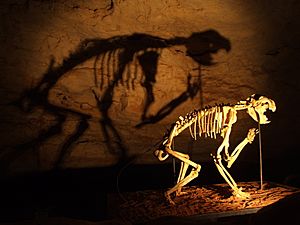
During the most recent Ice Age, global sea levels were lower. This revealed a large landmass called the Sahul Shelf, which connected Australia with New Guinea and Tasmania. So, when we talk about Australian megafauna during the Pleistocene, we usually mean the animals that lived across this entire Sahul landmass.
Ancient Australia was home to many unique animals. These included marsupials (like kangaroos), monotremes (like echidnas), crocodilians, turtles, monitor lizards, and many large flightless birds. Pleistocene Australia also had the giant short-faced kangaroo (Procoptodon goliah), Diprotodon (a giant wombat relative), the marsupial lion (Thylacoleo carnifex), the flightless bird Genyornis, the five-meter long snake Wonambi, and the giant monitor lizard Megalania. Since 450,000 years ago, 88 Australian megafauna species have gone extinct.
There are several ideas about why Australian megafauna went extinct. Most studies point to either climate change or human activity. However, scientists don't fully agree on which factor had a bigger impact. It's hard to create exact timelines for extinctions because there aren't many reliably dated megafauna bone sites.
Some studies suggest that climate change caused the extinctions in Australia. For example, researchers looked at fossilized teeth from southeastern Australia. By studying oxygen isotopes, they could tell how dry the climate was. By studying carbon isotopes and tooth wear, they learned about the megafauna's diets and the plants they ate. During the middle Pleistocene, many animals ate C4 plants. But by the late Pleistocene, they ate much less of these plants. This change might have been caused by drier conditions, which limited their food. This decline in C4 plants happened at the same time as the climate became drier. This suggests that increasing dryness stressed the megafauna and contributed to their decline.
Other researchers believe that human activity caused the extinctions, though this is a big debate. To figure out if humans caused an extinction, scientists look for three things:
- If animals went extinct after humans arrived but before a big climate event, humans might be the cause.
- If climate change during that time wasn't worse than in earlier times, then climate change probably wasn't the cause.
- If most megafauna were still alive when humans arrived, then human activity could be the reason.
Some researchers think humans were probably not responsible for most extinctions in Australia. They believe climate change was the cause. They argue that most megafauna species don't appear in the fossil record within 95,000 years of human arrival. They also say that the continent became drier over a long time, leading to extinctions starting as early as 130,000 years ago. These researchers don't completely rule out human influence. They point to evidence of human interaction with megafauna at one site, but argue that humans can only be blamed for the decline of a small number of species found there. They believe it's hard to pinpoint the main cause. Other researchers say that there's little clear archaeological evidence of humans hunting most megafauna.
The main exception is the giant bird, Genyornis. Between 54,000 and 47,000 years ago, burnt Genyornis eggshells show that humans cooked their eggs over campfires. This time period also matches the decline and extinction of Genyornis. Similar burnt emu eggs were found in many places from the same time. These widespread burnt eggshells suggest that humans arrived and spread quickly across Sahul. Despite this evidence for Genyornis, there isn't much evidence of humans interacting with other megafauna species. Many scientists interpret this lack of evidence to mean that humans didn't cause most megafauna extinctions in Australia.
However, other researchers disagree. They argue that the lack of hunting evidence doesn't mean hunting wasn't important. They say that archaeological evidence of hunting should be rare, even if it had a big impact, especially when humans first arrived. When humans first arrived, megafauna populations were very large, but human populations were small. So, human activity might not be very visible in the archaeological record. These researchers believe that the lack of evidence shouldn't rule out human-megafauna interactions as the main cause of extinctions in Australia.
Islands
Many islands had unique megafauna that disappeared when humans arrived, often in the last few thousand years or even more recently. These included:
- Dwarf woolly mammoths on Wrangel Island, St. Paul Island, and the Channel Islands of California.
- Giant birds in New Zealand like the moas and Hieraaetus moorei (a huge eagle).
- Many species in Madagascar: giant ground-dwelling lemurs (including Megaladapis and Archaeoindris), three species of hippos, two species of giant tortoises, the Voay-crocodile, and the giant bird Aepyornis.
- Five species of giant tortoises from the Mascarenes.
- A dwarf Stegodon (an elephant relative) on Flores and other islands.
- Land turtles and crocodiles in New Caledonia.
- Giant flightless owls and dwarf ground sloths in the Caribbean.
- Giant flightless geese and moa-nalo (giant flightless ducks) in Hawaii.
- Dwarf elephants and dwarf hippos from the Mediterranean islands.
- The Canary Islands also had their own extinct megafauna: giant lizards (Gallotia goliath), giant rats (Canariomys bravoi and Canariomys tamarani), and giant tortoises (Geochelone burchardi and Geochelone vulcanica).
See also
Images for kids
-
A Giant short-faced bear compared with a human.


